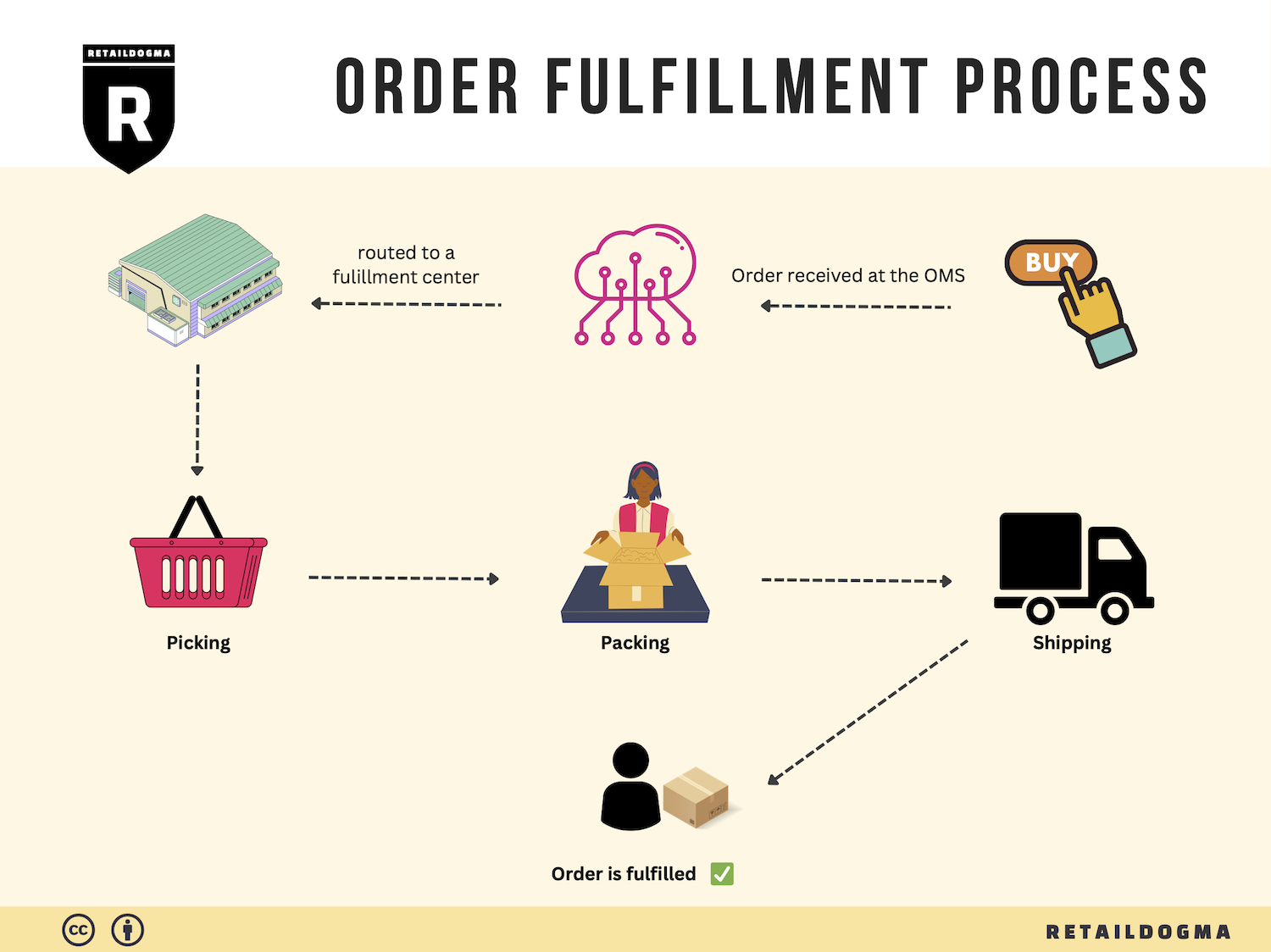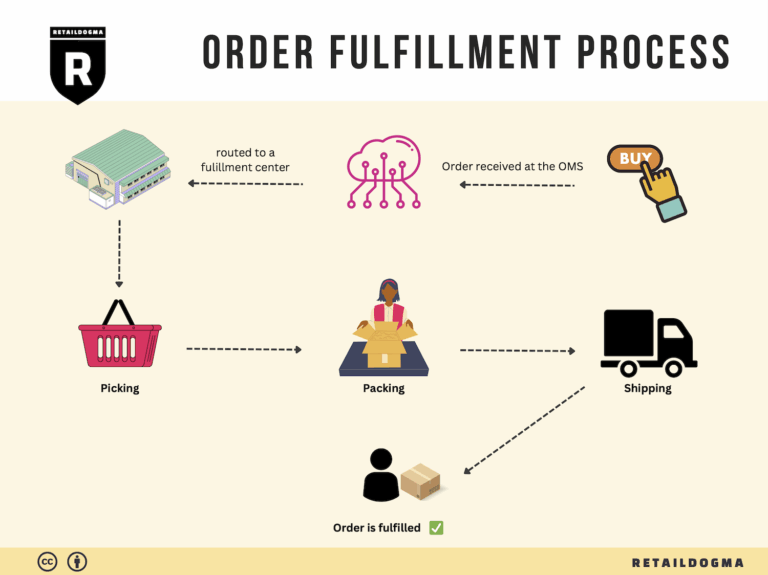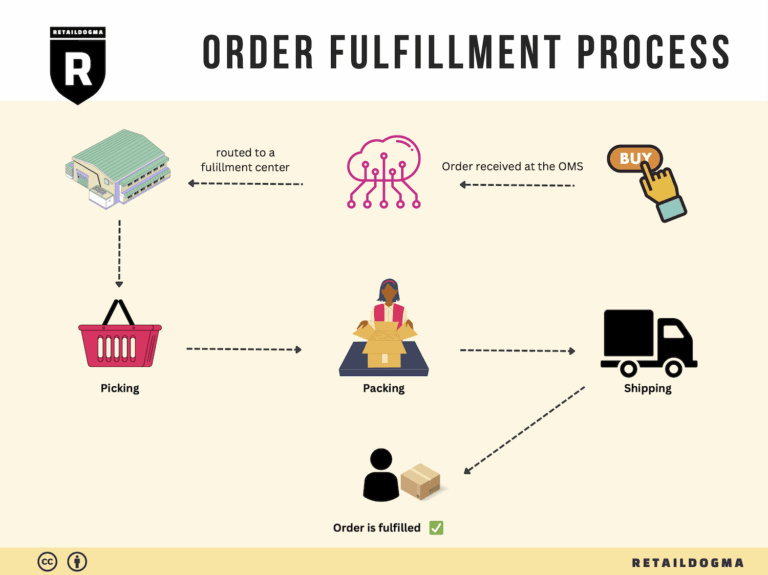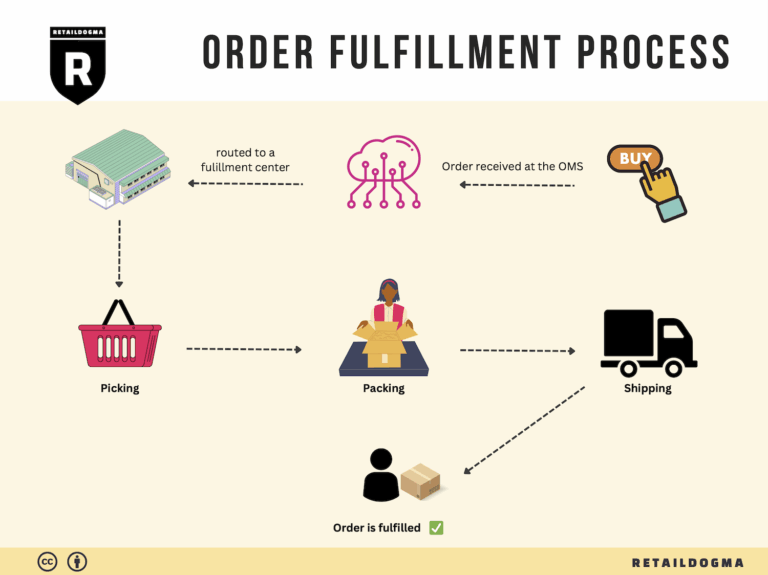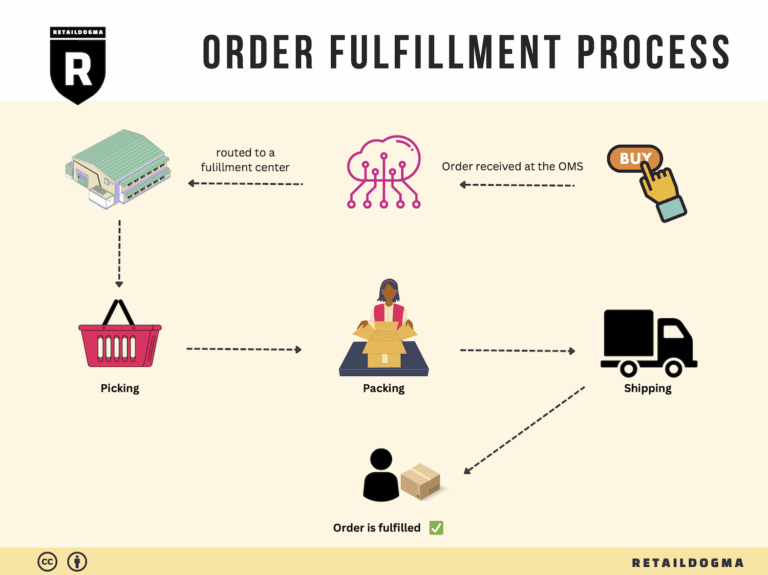How Order Fulfillment Works: A Step-by-Step Guide for Businesses
What is E-commerce Fulfillment? An Introduction for Growing Businesses
Navigating the Complexities of E-commerce Fulfillment
As your e-commerce business begins to flourish, the thrill of increased sales can quickly turn into the burden of managing order fulfillment. Many growing online retailers find themselves overwhelmed with the logistics of packing and shipping orders, which can detract from their ability to focus on core business strategies like marketing and product development. This is where understanding e-commerce fulfillment becomes crucial.
E-commerce fulfillment is fundamentally the process of getting products from your warehouse to your customers’ doorsteps. It encompasses everything from inventory management to packing orders, shipping, and handling returns. A seamless fulfillment process not only enhances customer satisfaction but also boosts your brand’s reputation and repeat business.
In this guide, we will delve into the various fulfillment models available to growing businesses, including third-party logistics (3PL) and Fulfillment by Amazon (FBA). Each model has its own set of advantages and challenges, and understanding these can help you choose the right one for your unique business needs.
We will also explore the core services that fulfillment partners typically offer, such as warehousing, inventory management, order processing, shipping, and returns management. Knowing what to expect from a fulfillment partner is essential for setting up a successful logistics operation.
Choosing the right fulfillment partner is another critical aspect that this guide will address. Factors such as location, technology integration, scalability, and customer service should weigh heavily in your decision-making process. We’ll provide insights into how to evaluate potential partners to ensure they align with your business goals and operational needs.
Finally, pricing is a pivotal consideration in the fulfillment landscape. We will outline the various costs associated with different fulfillment models, helping you to make informed financial decisions that support your growth objectives.
The goal of this guide is to empower e-commerce businesses to make smart, strategic decisions about their logistics operations. By mastering the intricacies of fulfillment, you can streamline your processes, enhance customer satisfaction, and ultimately fuel your business’s growth. Whether you’re just starting out or looking to optimize your existing operations, understanding e-commerce fulfillment is key to achieving your business aspirations.
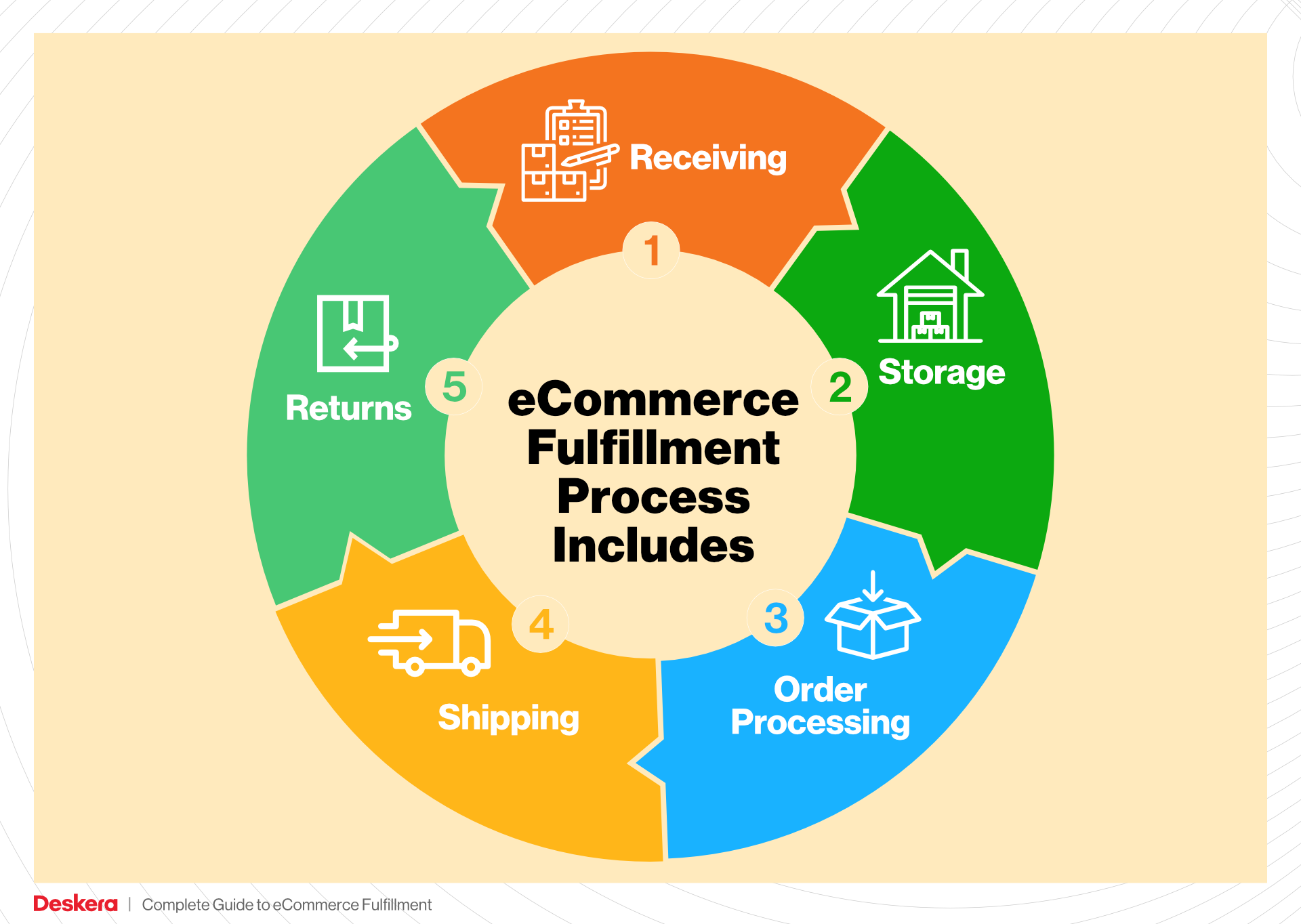
What You’ll Learn In This Guide
- What is E-commerce Fulfillment? An Introduction for Growing Businesses
- The Order Fulfillment Process: From ‘Buy’ Button to Customer’s Door
- Comparing Fulfillment Models: In-House vs. 3PL vs. Dropshipping
- A Deep Dive into Amazon FBA: Pros, Cons, and Who It’s For
- Core Services Offered by Fulfillment Centers
- How to Choose a Fulfillment Partner: A 6-Point Checklist
- Understanding Fulfillment Pricing: A Breakdown of Common Fees
- Frequently Asked Questions (FAQs) about Fulfillment
- Conclusion: Is Outsourcing Fulfillment the Right Move for Your Business?
- Important Disclaimer
The Order Fulfillment Process: From ‘Buy’ Button to Customer’s Door
1. Receiving Inventory
The order fulfillment process begins with the receiving of inventory at the fulfillment center. This step involves the systematic acceptance of goods from suppliers or manufacturers. Upon arrival, products are unloaded and verified against purchase orders to ensure that the correct items and quantities have been delivered. This is where the concept of Stock Keeping Units (SKUs) comes into play, as each product is assigned a unique SKU for efficient tracking.
This step is crucial because accurate receiving minimizes errors in inventory levels, preventing stockouts and overstock situations. Discrepancies at this stage can lead to significant issues downstream, such as delayed orders or customer dissatisfaction. A well-organized receiving area, equipped with scanners and inventory management software, ensures that this process is both efficient and accurate.
2. Warehouse Storage
Once the inventory has been received and checked, the next step is warehouse storage. This involves placing items in designated storage locations within the fulfillment center, organized in a manner that maximizes space and efficiency. Products are often stored based on their SKU, allowing for easy retrieval later in the order fulfillment process.
Effective warehouse storage is vital because it directly impacts order picking speed and accuracy. Utilizing techniques such as ABC analysis (categorizing inventory based on importance) can help prioritize which items are stored closer to the packing area, reducing the time spent retrieving products. An organized warehouse layout not only enhances operational efficiency but also improves employee safety and morale.
3. Order Picking
Order picking is the process of selecting items from storage to fulfill customer orders. When a customer places an order, a pick list is generated, indicating the specific SKUs and quantities needed. Warehouse employees then navigate the storage areas to gather these items. Various picking methods, such as batch picking (collecting multiple orders at once) or zone picking (assigning specific areas of the warehouse to different pickers), can be employed to enhance efficiency.
This step is critical as it directly influences order accuracy and speed. Mistakes during picking can lead to incorrect shipments, resulting in returns and customer dissatisfaction. Advanced technologies, such as pick-to-light systems or mobile scanning devices, can streamline this process, making it faster and more accurate. Ensuring that your team is well-trained and equipped with the right tools is essential for success in this stage.
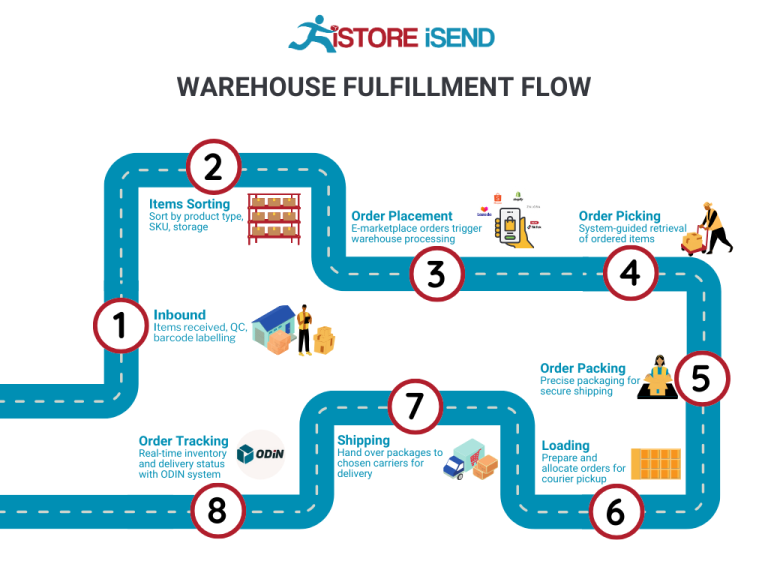
4. Order Packing
After items have been picked, they move to the packing stage. Here, products are carefully packed into boxes or containers, often using packing slips that detail the items included in the shipment. Proper packing is essential to protect products during transit and to ensure that they arrive in good condition. This is where the use of packing materials, such as bubble wrap, void fill, and tape, becomes important.
This step is crucial for minimizing damage during shipping and enhancing customer satisfaction. An efficient packing process can also reduce shipping costs by optimizing box sizes and weights. Businesses should consider implementing automated packing solutions or standardized packing processes to improve efficiency and reduce labor costs. Additionally, incorporating branding elements into the packing can enhance the customer experience and encourage repeat purchases.
5. Shipping & Delivery
The final step in the order fulfillment process is shipping and delivery. Once orders are packed, they are labeled and prepared for shipment. This involves selecting the appropriate shipping carriers and services based on factors such as delivery speed, cost, and destination. Businesses must also track shipments to provide customers with real-time updates on their order status.
Shipping is critical as it represents the last point of contact with the customer before they receive their order. A smooth and timely delivery can significantly enhance customer satisfaction and loyalty. Implementing a robust shipping strategy, including options for expedited shipping and easy returns, can set a business apart from its competitors. Utilizing shipping software to automate label generation and tracking can also streamline this process, ensuring that packages are dispatched quickly and accurately.
By understanding and optimizing each step of the order fulfillment process, e-commerce businesses can enhance their operational efficiency, improve customer satisfaction, and ultimately drive growth. Each stage, from receiving inventory to shipping and delivery, plays a vital role in the overall success of an e-commerce operation.
Comparing Fulfillment Models: In-House vs. 3PL vs. Dropshipping
Fulfillment Model Comparison
| Model | Who Handles Inventory | Best For (Business Stage) | Key Advantage | Key Disadvantage |
|---|---|---|---|---|
| In-House Fulfillment | The business itself | Established businesses | Complete control over inventory and operations | High overhead costs and resource demands |
| Third-Party Logistics (3PL) | A third-party provider | Growth stage businesses | Scalable and flexible logistics solutions | Less control over operations and inventory |
| Dropshipping | Supplier/Manufacturer | Startups or niche markets | Low upfront investment and no inventory management | Lower profit margins and reliance on suppliers |
In-House Fulfillment
In-house fulfillment involves managing all aspects of the storage, packing, and shipping processes within your own business operations. This model is best suited for established businesses that have the resources to invest in warehouse space, staffing, and technology. The primary advantage of in-house fulfillment is the complete control it offers over inventory management and order processing, allowing businesses to implement their own quality standards and customer service practices. Additionally, businesses can customize their packaging and shipping methods to enhance their brand experience.
However, the key disadvantage of this model is the high overhead costs involved. Maintaining a warehouse requires significant investment in real estate, equipment, and labor. Furthermore, as order volumes fluctuate, businesses may face challenges in scaling their operations efficiently. The resource demands of in-house fulfillment can also distract from core business activities, limiting growth potential if not managed carefully.
Third-Party Logistics (3PL)
Third-party logistics (3PL) providers offer outsourced logistics services, handling everything from warehousing to shipping for businesses. This model is particularly beneficial for companies in the growth stage, looking to scale their operations without the burdens of managing logistics in-house. 3PLs provide a flexible and scalable solution, allowing businesses to quickly adapt to changes in demand and expand their distribution networks without significant upfront investment in infrastructure.
The key advantage of using a 3PL is the ability to leverage the provider’s expertise and resources, which can result in more efficient shipping processes and potentially lower shipping costs due to their established networks. However, the main disadvantage is the reduced control over inventory and operations. Businesses must rely on the 3PL to maintain their standards, which can lead to inconsistencies in customer service and product handling if not carefully monitored. Additionally, any errors or delays in the fulfillment process can directly impact a business’s reputation.
Dropshipping
Dropshipping is a fulfillment model where the retailer does not hold inventory but instead transfers customer orders directly to a supplier, who then ships the products on behalf of the retailer. This model is ideal for startups or businesses focusing on niche markets, as it requires minimal upfront investment and eliminates the need for inventory management. Entrepreneurs can quickly test product ideas without the financial risk associated with traditional inventory models.
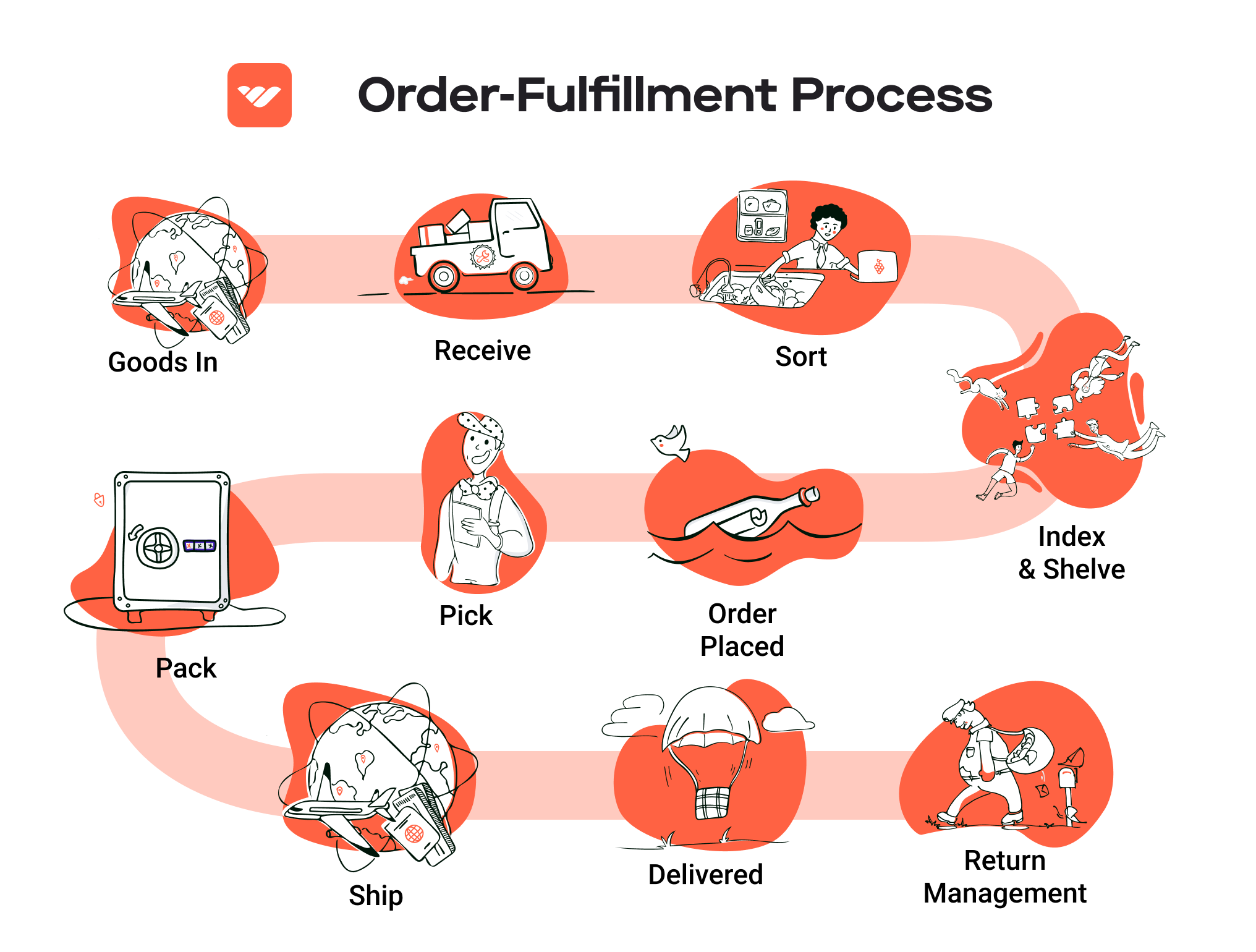
The primary advantage of dropshipping is the low barrier to entry, allowing businesses to operate without the costs of warehousing or logistics. It also enables a wide product range without the commitment to stock items. However, dropshipping comes with its own set of challenges. Profit margins can be lower compared to other fulfillment methods, as suppliers often charge higher prices for the convenience of handling shipping. Additionally, businesses are reliant on suppliers for inventory management and shipping, which can lead to delays and inconsistencies that reflect poorly on the retailer. In a competitive market, these limitations can hinder growth and customer satisfaction.
Conclusion
Selecting the right fulfillment model is crucial for e-commerce businesses aiming to scale effectively. Each model presents unique advantages and challenges, and the best choice often depends on the business’s current stage, resources, and strategic goals. Established businesses may benefit from the control of in-house fulfillment, while growing companies might find the scalability of 3PLs more advantageous. For those just starting, dropshipping can provide an accessible entry point into the market. Understanding these models can help e-commerce leaders make informed decisions that align with their operational capabilities and growth aspirations.
A Deep Dive into Amazon FBA: Pros, Cons, and Who It’s For
Understanding Fulfillment by Amazon (FBA)
Fulfillment by Amazon (FBA) is a service offered by Amazon that allows sellers to store their products in Amazon’s fulfillment centers. Amazon then takes care of storage, packaging, and shipping of the products directly to customers. This service also includes customer service and returns handling, enabling sellers to focus more on their business rather than logistics.
When a customer orders a product, Amazon picks, packs, and ships the product on behalf of the seller. This process can significantly streamline operations for e-commerce businesses, especially those looking to scale their sales and logistics capabilities.
How FBA Works
-
Setup: Sellers begin by creating an Amazon seller account and enrolling in FBA. They then send their inventory to Amazon’s fulfillment centers, where the products are stored until sold.
-
Storage: Products are stored in Amazon’s warehouses. Each item is scanned and tracked using Amazon’s advanced inventory management systems. Sellers can monitor their stock levels via their seller dashboard.
-
Order Fulfillment: When a customer places an order, Amazon’s system automatically picks the product from the warehouse, packs it, and ships it to the customer. This process is designed to be efficient, often resulting in same-day or next-day delivery for Prime members.
-
Customer Service: Amazon handles all customer inquiries and returns for FBA orders, providing a level of service that can enhance customer satisfaction and loyalty.
-
Payment: After the product is sold, Amazon deducts its fees and transfers the remaining amount to the seller’s account.
Pros of Using FBA
Prime Eligibility
Products fulfilled through FBA are eligible for Amazon Prime, which can significantly boost sales. Prime members are known to spend more on average than non-members, and they often prioritize Prime-eligible products during their shopping.
Customer Trust
Selling through Amazon gives sellers access to Amazon’s trusted brand, which can enhance credibility. Customers are more likely to purchase from a seller that utilizes FBA, knowing that their orders will be handled by Amazon, ensuring timely and reliable delivery.
Multi-Channel Fulfillment
FBA allows sellers to fulfill orders not only from Amazon but also from their own websites or other platforms. This flexibility means that sellers can manage their inventory in one place while reaching customers across multiple sales channels.
Scalability
As a business grows, FBA provides the infrastructure needed to scale without the burden of expanding logistics operations. Sellers can increase inventory levels and reach a larger customer base without having to manage warehousing and shipping logistics.
Simplified Logistics
FBA handles all aspects of fulfillment, from storage to shipping to returns. This can significantly reduce the operational complexity for sellers, allowing them to focus more on marketing and sales strategies.
Cons of Using FBA
High Fees
While FBA provides many benefits, it also comes with costs. Amazon charges sellers for storage space and fulfillment fees, which can eat into profit margins, especially for low-priced items. Sellers need to carefully analyze their pricing strategy to account for these fees.
Strict Inventory Rules
Amazon has specific guidelines regarding inventory management, including restrictions on the types of products that can be stored and how long items can remain in the warehouse. Non-compliance can lead to additional fees or even the removal of products from the platform.
Commingling Risks
When sellers use FBA, their inventory may be commingled with that of other sellers. This means that there is a risk of receiving returns or damaged goods that do not belong to them. This can lead to issues with product quality and customer satisfaction.
Loss of Control
By using FBA, sellers give up some control over their inventory and fulfillment processes. Any issues with Amazon’s logistics can impact their business, and sellers may face challenges in resolving such issues quickly.
Limited Branding Opportunities
FBA packages are branded with Amazon’s logo, which can limit sellers’ ability to create a distinct brand identity. This may hinder efforts to build brand loyalty among customers who associate their shopping experience primarily with Amazon.
Who is FBA Best For?
Fulfillment by Amazon is particularly beneficial for:
-
Small to Medium-Sized Businesses: Businesses looking to scale without investing heavily in logistics can leverage FBA to reach a larger audience while minimizing operational burdens.
-
New Sellers: For entrepreneurs just starting out, FBA provides an accessible way to enter the e-commerce space with built-in logistics and customer service.
-
Sellers with High Volume: Those with high sales volumes can benefit from the efficiencies of FBA, as the logistics cost per unit decreases with higher inventory turnover.
-
Seasonal Sellers: Businesses that experience spikes in sales during peak seasons (like holidays) can use FBA to handle increased order volumes without the need for additional warehousing or staffing.
-
Brands Seeking Trust: Brands looking to enhance their credibility and customer trust can benefit from the Amazon brand association and the reliability of FBA’s fulfillment services.
In conclusion, while Fulfillment by Amazon offers numerous advantages for e-commerce businesses seeking to streamline their operations and scale their sales, it is essential to weigh these benefits against the potential drawbacks. By understanding the intricacies of FBA, sellers can make informed decisions that align with their business goals.
Core Services Offered by Fulfillment Centers
Inventory Management & Warehousing
Fulfillment centers offer robust inventory management and warehousing services, which are essential for e-commerce businesses looking to scale efficiently. These centers use advanced inventory management systems that allow businesses to track stock levels in real-time, manage reorders, and optimize storage space.
Benefits:
1. Real-Time Visibility: E-commerce businesses gain access to real-time data regarding inventory levels, enabling them to make informed decisions about restocking and product launches. This minimizes the risk of stockouts or overstock situations, which can lead to lost sales or increased holding costs.
-
Space Optimization: With a fulfillment center handling warehousing, businesses can free up valuable space in their own operations. This is especially beneficial for small to medium-sized enterprises (SMEs) that may not have the capacity to store large quantities of products.
-
Scalability: As demand fluctuates, fulfillment centers can easily adjust storage capacity. This flexibility allows businesses to scale operations without the need for significant investments in real estate or infrastructure.
-
Cost-Effectiveness: By outsourcing warehousing, businesses can reduce overhead costs related to maintaining their own storage facilities, including utilities, rent, and staffing.
Pick and Pack Services
Pick and pack services are a core offering of fulfillment centers, where items are efficiently picked from shelves, packed into boxes, and prepared for shipment. This process is essential for ensuring that customers receive the correct products promptly.
Benefits:
1. Efficiency: Fulfillment centers utilize automated systems and trained personnel to streamline the pick and pack process. This leads to faster order fulfillment times, which is critical for maintaining customer satisfaction and loyalty in the competitive e-commerce landscape.
-
Accuracy: Advanced technologies, such as barcode scanning and inventory management software, reduce the likelihood of errors during the picking and packing stages. This minimizes the chances of sending incorrect items to customers, reducing returns and enhancing the overall customer experience.
-
Customization: Many fulfillment centers offer customizable packing options, allowing businesses to include branded materials, gift wrapping, or personalized notes. This enhances the unboxing experience for customers, reinforcing brand identity and increasing customer retention.
-
Scalability: During peak seasons, such as holidays or promotional events, fulfillment centers can ramp up their operations to handle increased order volumes, ensuring that businesses can meet customer demand without compromising service quality.
Kitting and Assembly
Kitting and assembly services involve the grouping of individual items into ready-to-sell products or kits. This service is particularly beneficial for businesses that sell products that require assembly or those that offer bundled items.
Benefits:
1. Time Savings: By outsourcing kitting and assembly, businesses can save time and resources that would otherwise be spent on these labor-intensive processes. This allows them to focus on core activities such as marketing and product development.
-
Quality Control: Fulfillment centers often have quality control measures in place to ensure that kits or assembled products meet specific standards before they are shipped. This reduces the risk of customer complaints and returns.
-
Enhanced Customer Experience: Offering pre-assembled kits or bundled products can increase the perceived value for customers, leading to higher sales and improved customer satisfaction. For instance, gift sets or themed bundles can attract more buyers during holidays or special occasions.
-
Inventory Management: Kitting can also help businesses manage inventory more effectively by consolidating multiple SKUs into a single product offering. This simplifies inventory tracking and can reduce holding costs.
Returns Management (Reverse Logistics)
Returns management, or reverse logistics, is a critical service offered by fulfillment centers that handle the complexities of product returns. This includes processing returns, restocking items, and managing customer refunds or exchanges.
Benefits:
1. Streamlined Process: A well-managed returns process enhances customer satisfaction by making it easy for them to return unwanted or defective products. Fulfillment centers typically have systems in place to manage returns efficiently, minimizing delays and frustrations for customers.
-
Data Insights: By analyzing return data, businesses can identify patterns or recurring issues with specific products. This information is valuable for making informed decisions about product quality, inventory management, and future purchasing strategies.
-
Cost Reduction: Effective returns management can help reduce costs associated with handling returns. Fulfillment centers often have established relationships with carriers, allowing them to negotiate better shipping rates for return shipments.
-
Brand Loyalty: A hassle-free returns process can significantly enhance customer loyalty. When customers feel confident that they can easily return items, they are more likely to make purchases, knowing that they have options if the product does not meet their expectations.
In conclusion, leveraging the core services offered by fulfillment centers can significantly streamline operations for e-commerce businesses. By focusing on inventory management, pick and pack services, kitting and assembly, and returns management, businesses can scale their logistics effectively, enhance customer satisfaction, and ultimately drive growth.
How to Choose a Fulfillment Partner: A 6-Point Checklist
Location & Warehouse Network
Why It’s Important:
The geographical location of your fulfillment partner’s warehouses plays a crucial role in your shipping efficiency. A partner with strategically placed warehouses can reduce shipping times and costs, allowing you to offer faster delivery options to your customers.
Questions to Ask:
– Where are your warehouses located, and how does this align with my customer base?
– Do you have multiple fulfillment centers, and can you provide a map of your network?
– How do you manage shipping to remote areas?
Technology & Integrations
Why It’s Important:
In today’s digital landscape, technology is the backbone of efficient fulfillment operations. A partner with advanced technology can streamline processes, provide real-time inventory tracking, and integrate seamlessly with your e-commerce platform.
Questions to Ask:
– What fulfillment management software do you use, and how does it integrate with my current systems?
– Can you provide real-time data on inventory levels and order status?
– Do you support automation in your processes, such as picking, packing, and shipping?
Specializations (e.g., cold storage, oversized items)
Why It’s Important:
Different businesses have unique needs based on the type of products they sell. If you deal with perishable goods, oversized items, or specialized products, it’s vital to partner with a fulfillment center that has the necessary facilities and expertise.
Questions to Ask:
– What types of specializations do you offer (e.g., cold storage, hazardous materials)?
– How do you handle inventory for specialized items?
– Can you accommodate unique packaging or shipping requirements for my products?
Scalability & Capacity
Why It’s Important:
As your business grows, your fulfillment needs will evolve. Choosing a partner that can scale with you ensures that you won’t face bottlenecks during peak seasons or when launching new products.
Questions to Ask:
– What is your current capacity, and how do you plan to scale in the next few years?
– How do you handle seasonal fluctuations in order volume?
– Are there any limits to the number of SKUs or order volume you can manage?
Pricing and Contracts
Why It’s Important:
Understanding the pricing structure and contract terms is essential for budgeting and financial planning. Hidden fees can significantly impact your bottom line, so clarity in this area is crucial.
Questions to Ask:
– Can you provide a detailed breakdown of your pricing structure?
– Are there any additional fees (e.g., storage, pick and pack, shipping)?
– What is the length of the contract, and what are the terms for termination or renewal?
Customer Support & Reviews
Why It’s Important:
Effective communication and reliable customer support are vital for resolving issues quickly. Additionally, researching reviews can provide insight into the partner’s reputation and reliability.
Questions to Ask:
– What customer support options do you offer (e.g., phone, chat, email)?
– Can you provide references or case studies from clients in my industry?
– How do you handle customer complaints or issues with orders?
Conclusion
Choosing the right fulfillment partner is a critical decision that can significantly impact your e-commerce operations. By systematically evaluating potential partners based on the above checklist, you can ensure that you select a fulfillment center that aligns with your business goals, enhances customer satisfaction, and supports your growth strategy.
Engaging with potential partners through these questions will also help you gain a deeper understanding of their capabilities and how they can meet your specific needs. Remember, a strong partnership can provide the logistical backbone that enables your business to thrive in a competitive marketplace.
Understanding Fulfillment Pricing: A Breakdown of Common Fees
Initial Setup Fees
When partnering with a fulfillment center like Amazon, businesses typically encounter initial setup fees. These fees are associated with the onboarding process and can vary significantly based on the provider. Initial setup may include costs for creating an account, integrating software systems, and establishing inventory management protocols.
For Amazon specifically, the setup process might involve configuring your seller account to connect seamlessly with their fulfillment services. While Amazon does not explicitly charge a fee for account setup, businesses should consider potential costs for third-party software integrations or consulting services if they require help navigating the platform.
Receiving Fees
Receiving fees are charged when your inventory arrives at the fulfillment center. This fee covers the labor and resources needed to unload, inspect, and store your products. For Amazon, this fee is typically calculated per pallet or per unit, depending on the size and weight of the items being received.
For example, if you send a shipment of 10 pallets, you would pay a per-pallet fee multiplied by the number of pallets received. It’s essential to ensure that shipments are well-packaged and labeled correctly to avoid additional charges related to damage or mislabeling.
Storage Fees (per pallet/bin)
Storage fees are incurred for keeping your inventory in the fulfillment center. These fees are usually calculated based on the space your products occupy, measured in pallets or bins. Amazon applies monthly storage fees that vary based on the time of year; generally, they are higher during peak seasons like Q4 (the holiday season) when demand spikes.
For example, if you have 20 pallets stored in Amazon’s facility, you will pay a monthly fee that multiplies the number of pallets by the applicable rate. To minimize storage fees, businesses should regularly monitor their inventory levels and implement strategies to reduce excess stock, such as promotional campaigns or discounts.
Pick & Pack Fees (per item/order)
Pick and pack fees are charged for the labor involved in selecting items from storage and preparing them for shipment. This includes picking the items, packing them securely, and labeling them for delivery. Amazon calculates this fee on a per-item or per-order basis, depending on the specifics of the order.
For instance, if an order consists of three different items, you may be charged a fee for picking each item and an additional fee for packing the entire order. Businesses should consider optimizing their product offerings to reduce the complexity of orders, which can help lower pick and pack fees.
Shipping Fees
Shipping fees are the costs associated with delivering orders to customers. These fees can vary widely depending on factors such as package weight, dimensions, destination, and the shipping method selected (e.g., standard, expedited, or same-day delivery).
Amazon typically offers tiered shipping rates, which may include discounted rates for larger volumes or certain shipping methods. Understanding your target market’s preferences for shipping speed can help you choose the most cost-effective options while maintaining customer satisfaction.
Tips for Getting an Accurate Quote
-
Detailed Inventory List: Provide a comprehensive list of your products, including dimensions, weight, and packaging details. This helps fulfillment centers accurately assess storage and shipping costs.
-
Volume Estimates: Share your expected order volume and frequency. Many fulfillment centers offer tiered pricing based on the volume of orders, so understanding your sales projections can yield better rates.
-
Clarify Services Needed: Be clear about the specific services you require, such as custom packaging or additional handling. This can impact pricing significantly.
-
Request Multiple Quotes: Don’t settle for the first quote you receive. Reach out to multiple fulfillment providers to compare costs and services, ensuring you choose the best fit for your business needs.
-
Negotiate: Many fulfillment centers are open to negotiation, especially if you can offer them a higher volume of business. Don’t hesitate to discuss pricing options to secure the best deal.
By understanding these common fulfillment pricing models and following these tips, e-commerce business owners can better manage their logistics costs and optimize their supply chain operations.
Frequently Asked Questions (FAQs) about Fulfillment
1. What is an Amazon Fulfillment Center?
An Amazon Fulfillment Center is a large warehouse facility where Amazon stores, picks, packs, and ships products to customers. These centers are designed to streamline the logistics process and ensure quick delivery of items ordered through Amazon, utilizing advanced technology and a significant workforce to manage inventory and fulfill orders efficiently.
2. How does the Amazon Fulfillment Center in Middletown, Delaware, operate?
The Middletown Fulfillment Center operates by receiving products from various suppliers, storing them in a highly organized manner, and using automated systems and human workers to pick and pack items when orders are placed. The facility is equipped with advanced robotics that help in efficiently managing inventory and speeding up the shipping process.
3. What types of products are stored at the Middletown Fulfillment Center?
The Middletown Fulfillment Center stores a wide range of products, including household essentials, electronics, clothing, and luxury items. Essentially, it caters to the diverse needs of Amazon customers, ensuring a comprehensive selection is available for quick shipping.
4. What’s the difference between a warehouse and a fulfillment center?
A warehouse is primarily a storage facility that holds inventory until it is needed, while a fulfillment center is specifically designed to process and ship orders directly to customers. Fulfillment centers incorporate advanced technology and logistics processes to handle order fulfillment efficiently, often including packaging and shipping services.
5. What is a 3PL (Third-Party Logistics)?
A 3PL, or Third-Party Logistics provider, is a service that allows businesses to outsource their logistics and supply chain management. This includes warehousing, order fulfillment, and shipping. By partnering with a 3PL, companies can focus on their core business operations while leveraging the expertise and resources of the logistics provider.
6. How much do fulfillment services cost?
Fulfillment service costs can vary significantly based on several factors, including the volume of orders, the types of products being stored and shipped, and the specific services required (such as packaging and returns handling). Generally, costs may include storage fees, pick and pack fees, shipping fees, and any additional services. It is advisable to request quotes from different fulfillment providers to compare pricing structures.
7. How can I get my products into the Amazon Fulfillment Center in Middletown?
To have your products stored and shipped from the Amazon Fulfillment Center, you will need to enroll in the Fulfillment by Amazon (FBA) program. This involves creating an Amazon seller account, preparing your inventory according to Amazon’s guidelines, and shipping it to the fulfillment center. Once your products are received, they will be listed for sale on Amazon.
8. What are the benefits of using Amazon’s fulfillment services?
Using Amazon’s fulfillment services offers several benefits, including access to Amazon’s vast customer base, fast shipping options (like Prime), and the ability to leverage Amazon’s logistics infrastructure. Additionally, sellers can focus on marketing and product development while Amazon handles the complexities of order fulfillment and customer service.
9. What kind of jobs are available at the Amazon Fulfillment Center in Middletown?
The Amazon Fulfillment Center in Middletown offers a variety of job opportunities, including positions in warehouse operations, inventory management, shipping and receiving, and logistics coordination. Roles may range from entry-level positions to management and specialized technical roles, often with competitive pay and benefits.
10. How does Amazon ensure the safety and security of products in its fulfillment centers?
Amazon employs multiple safety and security measures to protect products in its fulfillment centers. This includes surveillance systems, secure access controls, and strict inventory management protocols. Additionally, employees undergo training on safety practices to minimize risks and ensure a secure working environment.
Conclusion: Is Outsourcing Fulfillment the Right Move for Your Business?
Evaluating the Benefits of Outsourcing Fulfillment
Outsourcing fulfillment can be a game-changer for e-commerce businesses looking to scale effectively. The primary advantages include significant time savings, enhanced scalability, and access to specialized expertise. By entrusting fulfillment to a partner, businesses can focus on core activities such as marketing and product development, rather than the logistical complexities of order fulfillment and shipping.
Time is a precious commodity for any entrepreneur. Managing inventory, packing orders, and coordinating shipping can consume valuable hours that could be better spent on strategic initiatives. Outsourcing these tasks allows business owners to streamline operations, reduce overhead, and ultimately improve efficiency. Additionally, as demand fluctuates, a capable fulfillment partner can easily scale operations up or down, ensuring that businesses can adapt quickly to market changes without the burden of excess capacity or staffing issues.
Moreover, fulfillment centers, especially those operated by established players like Amazon, bring a wealth of expertise and cutting-edge technology to the table. From advanced inventory management systems to optimized shipping processes, leveraging such resources can enhance customer satisfaction through faster deliveries and improved service quality.
However, the success of outsourcing fulfillment hinges on selecting the right partner. Businesses must conduct thorough due diligence to ensure that their chosen fulfillment provider aligns with their operational needs and growth objectives. A misalignment can lead to service disruptions and negatively impact customer experiences.
As you contemplate whether outsourcing fulfillment is the right move for your business, take a moment to audit your current shipping processes. Assess the time, resources, and costs involved in managing fulfillment in-house. This exercise will provide clarity on whether partnering with a fulfillment service could drive your business growth more effectively. Embrace the opportunity to evolve and scale—your customers will thank you for it.
Important Disclaimer
⚠️ Important Disclaimer
The information in this guide is for educational purposes. Fulfillment services, pricing, and platform features change frequently. Always conduct your own due diligence and consult with providers directly before making business decisions.
